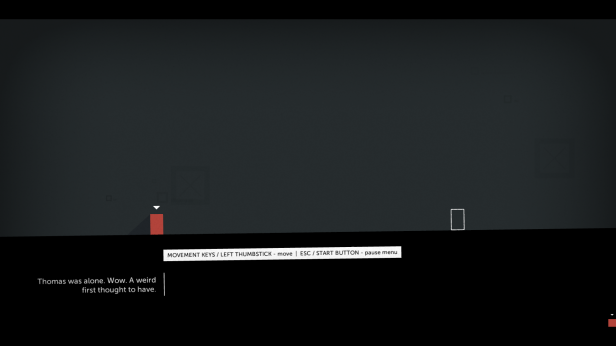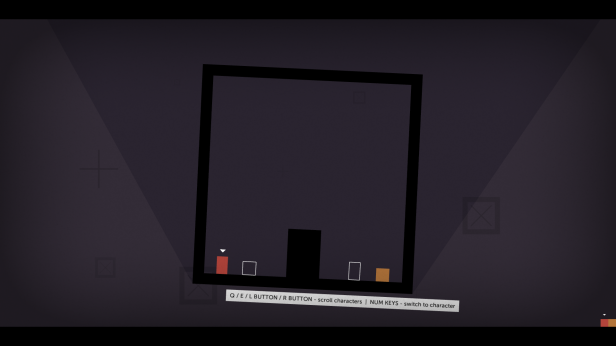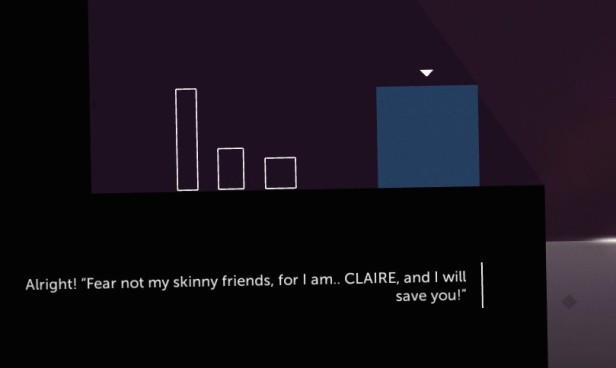Thomas Was Alone is a two-dimensional platforming game where one controls shapes with varying abilities. That is as much of a bare-bones description of the game as I can give about it. Leaving it at that would do the experience of playing the game a huge disservice. It was developed by Mike Bithell and is a wonderful look into how to create dynamic, three-dimensional characters in a two dimensional space. The first character we are introduced to is Thomas, an artificial intelligence who has become aware of some greater purpose he tries to fulfill. That is all the direct information that is given as the player sets out on their adventure. The first level and line of dialogue actually helps clue in to a lot more about what the game world wants us to know.

Information is not just left to text. A narration gives more observation and explanation of the world and characters than speaking directly for them in the game. The first sentence is, “Thomas was alone,” which gives the player some valuable details. First, the rectangle had a name. It wasn’t just “the red one,” but a known, human name that begins to create a personality for the shape. Next it says he was alone, showing how the player is not a known part of his world and his loneliness was not going to be a constant. Thomas is shown to be capable of thought and feeling but all the player can do at first is move to the right and fit into the conveniently shaped outline. Doing so advances one to the next level and this continues for a while, the game itself even mentioning the fact that Thomas has the compulsion to move “up and to the right.” After a few levels of loneliness, Thomas encounters the others.
The first encounter is with Chris, an orange square. He has the same capabilities and controls as Thomas, but he cannot jump as high and is a bit shorter than his counterpart. His introduction portrays him as someone who may have preferred to be alone as opposed to Thomas who was happy to be leaving his loneliness behind him. At this moment in my playthrough, I began to make my own decisions about these characters. I could think of what they would look like in the real world and could almost tell what expressions I thought they were making at any given moment. By keeping these characters as shapes, the game is allowing its players to draw their own conclusions as to how they look and interact outside of what is given by the narration. They are also forced to interact with one another in order to progress, as the game allows the player to figure out how to utilize both Thomas and Chris. Sometimes a path is too small for Thomas to fit so Chris must progress on his own, or stairs may be too high of a jump for Chris so Thomas has to give him a boost. Along with personality, the game is familiarizing its player with how each character fits into solving puzzles throughout the narrative.

After giving the player time to work with characters with variations in size and jump height, it begins to add new elements to each new companion. There is a horizontal line that acts as a trampoline, a rectangle that can double jump, someone who has gravity affect him in the opposite direction, and my personal favorite, one who can survive and float in the water. Up until the player meets Claire, the large blue square, water is avoided as it causes the character to revert to a checkpoint or start the level over. There aren’t many ways to “die” in Thomas Was Alone, but what the player had been strictly avoiding is now going to play a crucial role in advancing the story. Claire is large enough to ferry multiple companions over water and the narrator describes her as feeling like a superhero when she does. It’s additions like these that can change the way the entire game is approached. Much like a new item received in an adventure game to access a new area of the world, a new character brings with them a new capability that must be used by the player. This source of change in the game fits into what was described in the very beginning. If Thomas was getting new abilities to shrink, float, or jump twice, he would still be alone and nothing would have changed throughout the game. The whole point of this story and its characters is to prove how they can accomplish something alone, but working together as a whole allows them to advance beyond what they originally perceived possible.
There is a looming sense of importance and urgency to what you are accomplishing throughout the game and it continues to explain itself as more narration and some text interviews are given. The music alone helps clue the player into the tone of the current level. It serves as a complimentary feature that is always present but never interfering. Because there is no direct emotion expressed by the colored shapes, it is left to the music and pace of the level design to convey how important, somber, or ecstatic events are as they unfold, and it does this masterfully.
Thomas Was Alone is able to convey more character and emotion in its short game span and shapely characters than some games that have more readily identifiable characters and larger worlds to traverse. Each player will define the details of their characters differently while playing the exact same game. The simplicity of its design allows for a greater sense of character connection. The abilities of each shape make for a challenge in puzzle solving that begins to seem like a team effort guided by the player. If you choose to give this game a shot, you’ll find yourself putting faces of people you know with rectangles and feel like you accomplished something great with your quadrilateral companions.

